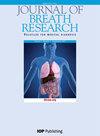快速护理点呼气试验可预测有症状妇女的乳腺癌和异常乳房 X 光检查。
IF 3.4
4区 医学
Q1 BIOCHEMICAL RESEARCH METHODS
引用次数: 0
摘要
以往的研究报告称,呼气中的挥发性有机化合物(VOC)是乳腺癌的生物标志物。这些生物标志物可能来自与癌症相关的成纤维细胞,在成纤维细胞中,氧化应激将多不饱和脂肪酸降解为挥发性烷烃和甲基化烷烃衍生物,并随呼吸排出体外。我们评估了一种快速的呼气挥发性有机化合物生物标志物床旁检测方法,该方法可预测乳腺癌和乳房 X 光检查异常:我们对 593 名年龄≥ 18 岁的女性进行了研究,她们因乳房相关症状(如乳房肿块、乳头溢液)而被转诊到三个地点进行乳房 X 光检查。快速护理点呼气检测系统在吸附剂捕集器上收集并浓缩肺泡呼气中的挥发性有机化合物,并在 < 6 分钟内用气相色谱法和表面声波检测法对其进行分析。呼气挥发性有机化合物色谱图被随机分配到训练集或验证集。蒙特卡洛分析确定了训练集中乳腺癌和乳房 X 线照片异常的重要呼出气体挥发性有机化合物生物标志物,并将这些生物标志物纳入多元算法,以预测验证集中的疾病:乳腺癌预测:50 名妇女经活检证实患有乳腺癌(浸润性癌症 41 例,导管非浸润性癌症 9 例) 未拆分数据集:呼吸挥发性有机化合物识别乳腺癌的准确率为 83%(接收者操作特征曲线下面积),灵敏度为 82%,特异性为 77.1%:训练集呼气 VOCs 鉴定乳腺癌的准确率为 80.3%,灵敏度为 84%,特异性为 74.3%。验证集的相应准确率为 68%%,灵敏度为 72.4%,特异性为 61.5%。 预测 BIRADS 4 和 5 乳房 X 线照片(相对于 BIRADS 1、2 和 3): 未拆分数据集:呼吸 VOC 识别异常乳房 X 光照片的准确率为 76.2%:呼吸 VOCs 识别异常乳房 X 光照片的准确率为 74.2%,灵敏度为 73.3%,特异性为 60%。验证集中的相应值为:准确率 60.5%、灵敏度 64.2%、特异性 51%:呼出挥发性有机化合物生物标记物的快速床旁检测可预测有乳腺相关症状的妇女罹患乳腺癌的风险和乳房 X 光检查异常的情况。本文章由计算机程序翻译,如有差异,请以英文原文为准。
Rapid point-of-care breath test predicts breast cancer and abnormal mammograms in symptomatic women.
Previous studies have reported volatile organic compounds (VOCs) in the breath as biomarkers of breast cancer. These biomarkers may be derived from cancer-associated fibroblasts, in which oxidative stress degrades polyunsaturated fatty acids to volatile alkanes and methylated alkane derivatives that are excreted in the breath. We evaluated a rapid point-of-care test for breath VOC biomarkers as predictors of breast cancer and abnormal mammograms.
Methods: We studied 593 women aged ≥ 18 yr referred to three sites for mammography for a symptomatic breast-related concern (e.g. breast mass, nipple discharge). A rapid point-of-care breath testing system collected and concentrated alveolar breath VOCs on a sorbent trap and analyzed them with gas chromatography and surface acoustic wave detection in < 6 min. Breath VOC chromatograms were randomly assigned to a training set or to a validation set. Monte Carlo analysis identified significant breath VOC biomarkers of breast cancer and abnormal mammograms in the training set, and these biomarkers were incorporated into a multivariate algorithm to predict disease in the validation set.
Results: Prediction of breast cancer: 50 women had biopsy-proven breast cancer (invasive cancer 41, ductal non-invasive cancer 9)
Unsplit data set: Breath VOCs identified breast cancer with 83% accuracy (area under curve of receiver operating characteristic), 82% sensitivity and 77.1% specificity.
Split data sets: Training set breath VOCs identified breast cancer with 80.3% accuracy, 84% sensitivity and 74.3% specificity. Corresponding values in the validation set were 68%% accuracy, 72.4% sensitivity and 61.5% specificity.
Prediction of BIRADS 4 and 5 mammograms (versus BIRADS 1, 2 and 3):
Unsplit data set: Breath VOCs identified abnormal mammograms with 76.2% accuracy.
Split data sets: Breath VOCs identified abnormal mammograms with 74.2% accuracy, 73.3% sensitivity and 60% specificity. Corresponding values in the validation set were 60.5% accuracy, 64.2% sensitivity and 51% specificity.
Conclusions: A rapid point-of-care test for breath VOC biomarkers predicted risk of breast cancer and abnormal mammograms in women with breast-related symptoms.
.
求助全文
通过发布文献求助,成功后即可免费获取论文全文。
去求助
来源期刊

Journal of breath research
BIOCHEMICAL RESEARCH METHODS-RESPIRATORY SYSTEM
CiteScore
7.60
自引率
21.10%
发文量
49
审稿时长
>12 weeks
期刊介绍:
Journal of Breath Research is dedicated to all aspects of scientific breath research. The traditional focus is on analysis of volatile compounds and aerosols in exhaled breath for the investigation of exogenous exposures, metabolism, toxicology, health status and the diagnosis of disease and breath odours. The journal also welcomes other breath-related topics.
Typical areas of interest include:
Big laboratory instrumentation: describing new state-of-the-art analytical instrumentation capable of performing high-resolution discovery and targeted breath research; exploiting complex technologies drawn from other areas of biochemistry and genetics for breath research.
Engineering solutions: developing new breath sampling technologies for condensate and aerosols, for chemical and optical sensors, for extraction and sample preparation methods, for automation and standardization, and for multiplex analyses to preserve the breath matrix and facilitating analytical throughput. Measure exhaled constituents (e.g. CO2, acetone, isoprene) as markers of human presence or mitigate such contaminants in enclosed environments.
Human and animal in vivo studies: decoding the ''breath exposome'', implementing exposure and intervention studies, performing cross-sectional and case-control research, assaying immune and inflammatory response, and testing mammalian host response to infections and exogenous exposures to develop information directly applicable to systems biology. Studying inhalation toxicology; inhaled breath as a source of internal dose; resultant blood, breath and urinary biomarkers linked to inhalation pathway.
Cellular and molecular level in vitro studies.
Clinical, pharmacological and forensic applications.
Mathematical, statistical and graphical data interpretation.
 求助内容:
求助内容: 应助结果提醒方式:
应助结果提醒方式:


